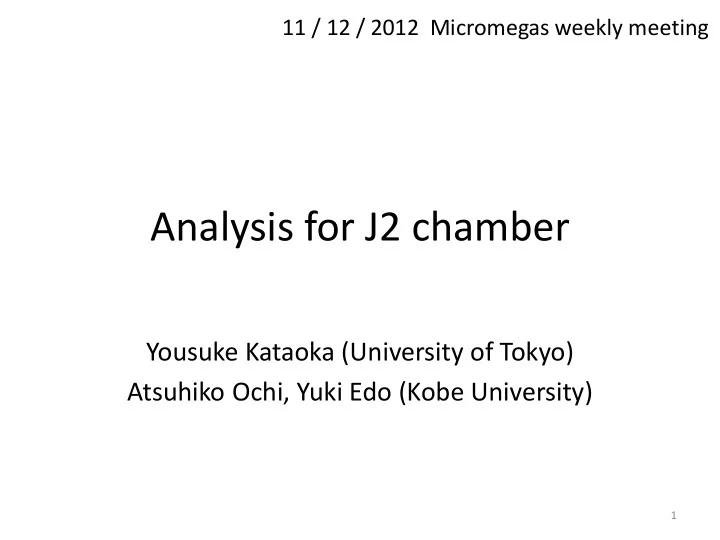

11 / 12 / 2012 Micromegas weekly meeting Analysis for J2 chamber Yousuke Kataoka (University of Tokyo) Atsuhiko Ochi, Yuki Edo (Kobe University) 1
Introduction • J2 chamber is made in Kobe (with Raytech) – Print screen 400um pitch Z1 Z2 J2 – 1 dimentional readout (2d for Z1,Z2) – 100um mesh gap (128um for Z1,Z2) beam – 15mm drift gap (5mm for Z1,Z2) • H6 test beam 19~25 Nov. – Run 8325~8500 by APV – 0,+10,+20,+30,+40 degree – HV_strip, HV_drift scan – some time with Z1, Z2 Tmm5,6 Tmm2,3 2
Chamber efficiency chamber efficiency = at least 1 cluster on J2 1 cluster on Tmm2,3,5,6 conditions - ZS factor = 0.8 -reject 1 strip cluster -require cluster Q > 100 -allow gap up to 12 in cluster • J2 reach >99% at 430V, Zebra at 550V • The difference come from mesh gap, drift gap, 1D or 2D • drop at larger angle due to smaller Q / strip 3
Strip efficiency At larger angle, some drops of strips within cluster strip efficiency == strip at center hit ? Number of hits (40 degree) 20 30 40 - even when chamber efficiency is 100%, 4 strip efficiency could be much low impact on perfomance
Comparison to Garfield 1. Garfield 9 (fortran) 2. assign gas gain 3. assign shape ~51 electrons (5mm,0 deg.) APV25 PDF from Garfield drift timing CR- RC shaper τ = 50ns &position t/50 x exp(- t/50) 4. give jitter 5. digitize 6. threshold 25ns bin threshold for charge ~ strip efficiency T T + random(25ns) X X + random(profile) 400um bin 7. compare to data basically every plots (full simulation) 5
Cluster width good agreements assume 100% strip effi. wider than Zebra 6
Timing width drift velocity T_qmax width [Tbin] roughly consistent (need to check) 7
Position resolution Center = (left + right) /2. J2 x 400um – (Tmm2 + Tmm3 + Tmm5 + Tmm6)/4 x 250um / cos(theta) resolution = sigma / sqrt(1+1/4) after introducing strip efficiency, agreement is good 8
Time resolution Constant fraction threshold = 50% J2 x 25ns – (Tmm2 + Tmm3 + Tmm5 + Tmm6)/4 x 25ns resolution = sigma / sqrt(1+1/4) CFD=50% pile up effect at 0 degree CFD=25% (CDF not work) delay was not enough probably optimistic 9
TPC Angle ~ 1 degree J2(0) … 0.100 1.9 degree 4.7cm/us wide gap is good for TPC J2(10) … -0.639 12.1 J2(20) … -1.097 20.2 J2(30) … -1.678 29.4 J2(40) … -2.386 38.7 Z1(20) … -1.296 23.5 10 Z2(20) … -1.290 23.4
Summary • J2, Z1, Z2 are working fine and in good agreement with Garfield simulation (many points need to be understood …) • strip efficiency affects performance, so higher voltage (lower threshold) is better (not just chamber 100% efficiency) • wider drift gap (wrt. pitch) is not good for strip efficiency and clustering, but better for TPC reconstruction 11
backup 12
13
14
CFD=25% (log) CFD=25% CFD=50% (log) CFD=25% log scale CFD=50% 15
16
Time resolution Constant fraction threshold = 25% J2 x 25ns – (Tmm2 + Tmm3 + Tmm5 + Tmm6)/4 x 25ns resolution = sigma / sqrt(1+1/4) 17
Recommend
More recommend